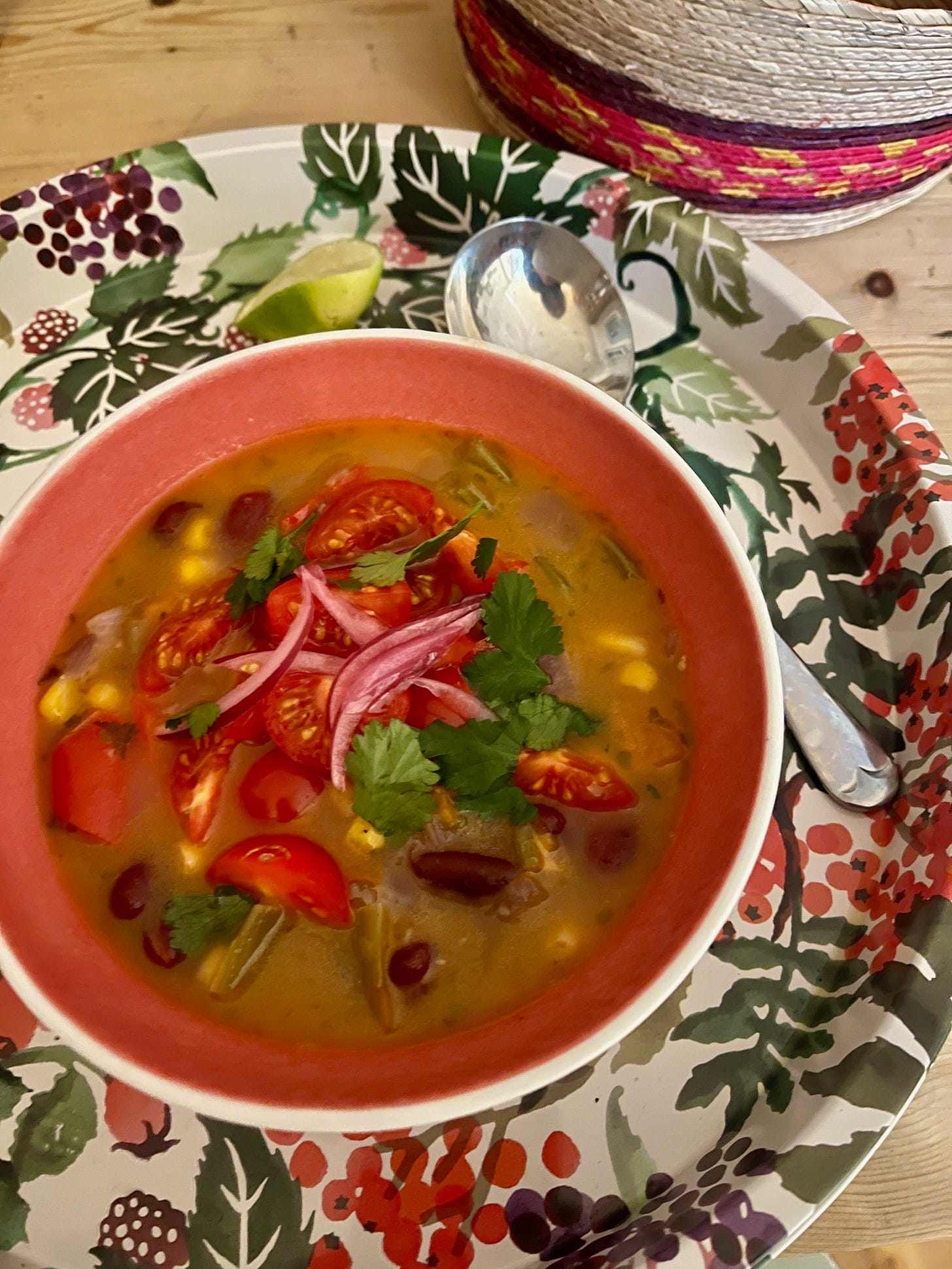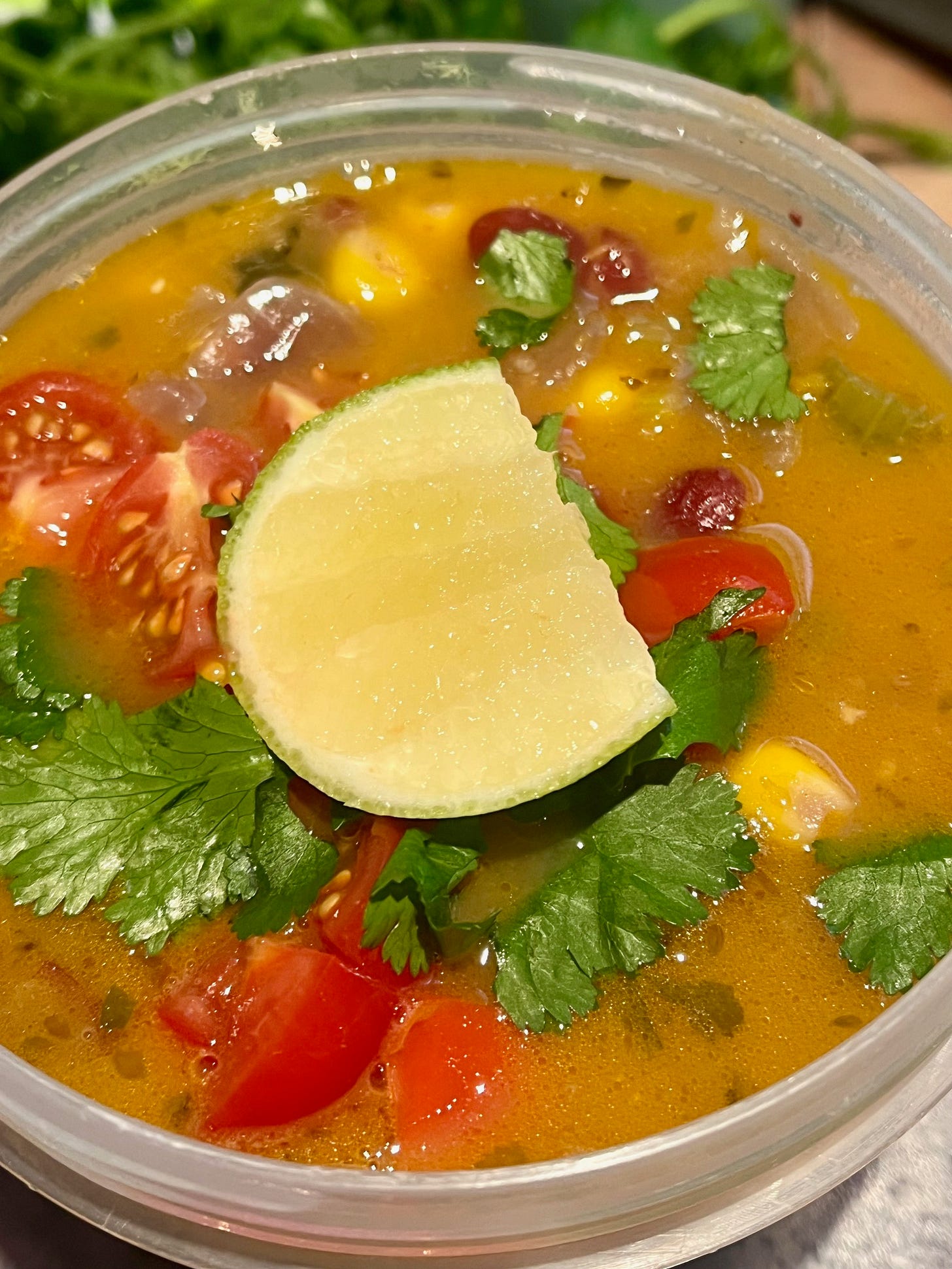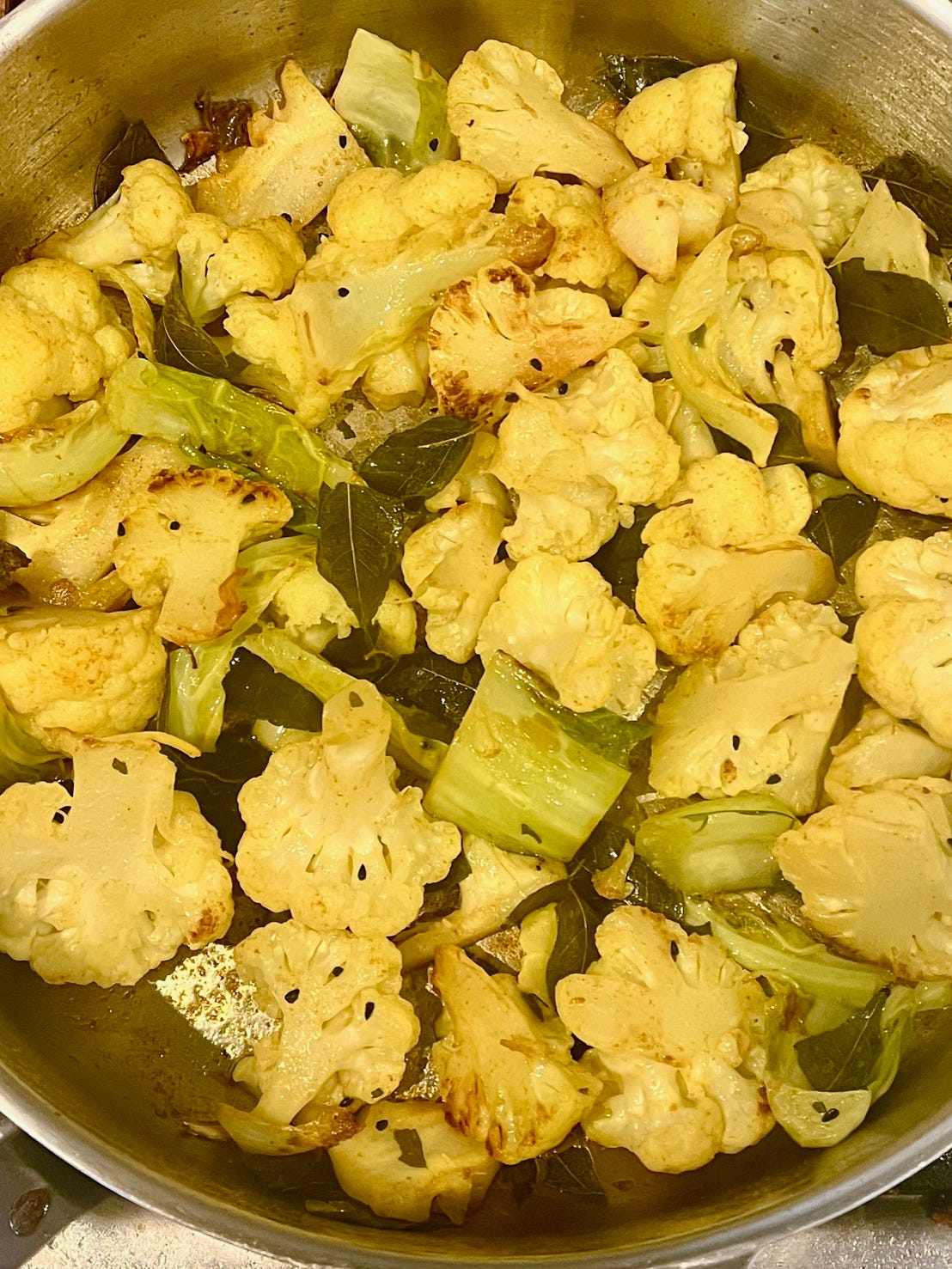Making the most of a batch of beans
3 vegan recipes - a coconutty soup, and a peanutty curry and a simple, seasonal citrussy salad.
Recently I cooked a big batch (a kilo bag) of red kidney beans; the beans had been hiding out at the back of the cupboard for some time, and needed using up. I was making a classic chilli con carne so it seemed like the ideal opportunity. But when given the chilli the reaction from 1 out of 3 of my beloved family was “UGGGHHH why have you used THOSE beans, no one likes them!” And why hadn’t I used pinto or black beans instead, like a sensible person?
Red kidney beans were always a bean of last resort for me too, in fact I used to actively avoid using them. But that was years ago when I used to rely on tins, before I started pressure cooking them. When I finally started pressure cooking them, I realised that they didn’t taste quite as I thought they did, being mild, sweet and creamy, verging on bland (beans, are, after all, pretty good flavour carriers), without the slightly off putting metallic after taste I associated with them, so now I use them quite happily. And I hadn’t realised that Shariq was eating them under duress - he is good about eating anything I say is a work recipe - and that pretty much is the only time we’ve eaten red kidney beans.
It turns out that Shariq assumed he didn’t like kidney beans because he used not to like tinned kidney beans and hadn’t really noticed that the kidney beans he’d been eating for the last decade were quite nice actually*.
Anyway, relief all round because the 1kg dried turned into around 2.6kg cooked which is quite a lot of beans to get through.
Bean Economics
Let me just remind you about the economics of this. These figures are based on a quick look at current prices, looking at everywhere from all the supermarkets to online shops, all ranges, from the basics ranges to organics.
1 tin = 230/240g cooked beans, to get 2.6kg you would need 11 tins.
A tin of kidney beans costs between 33p for the budget range - £1.39 for organics. So buying 11 tins - the equivalent of our 2.6kg cooked kidney beans - would cost between £3.58 and £15.06, more if you buy the even more expensive jarred sort.
A 1kg bag of kidney beans costs between £2.00 and £5.93 (no basics ranges here, but cheapest I can find and organics). And if you buy in larger quantities, you end up paying considerably less per kilo. So savings all round but clearly you are saving a lot more at the top end of the range. Of course, there is the fuel cost too, but using my most efficient method, this is just a few minutes on the hob. And I hope that I don’t need to remind you that a home cooked bean is vastly superior to a tinned bean!
All the recipes below use cooked beans, so a reminder on how to do this - soak in salted water (a teaspoon is enough), for at least 3 hours, up to overnight. Change the water, cover and add oil and any aromatics you like. Bring up to high pressure, cook for 2 minutes, then leave to drop pressure naturally. Leave for 15 minutes before opening.
And it goes without saying that OF COURSE you can use a different bean - or a chickpea - if you don’t like red kidney beans either.
Coconutty Bean and Vegetable Soup
This is a bright sunshiny soup which we ate on a day of more anticyclonic gloom and drizzle (fortunately over for now. 16C and sunny today!) It is vegan - made so, so I could give a portion to my vegetarian neighbour. My default is chicken stock but I am trying not to use it all the time so I can share more. Instead - and please don’t judge me - when I don’t have intensely reduced and fatty chicken stock to add to my own portion, I sometimes whisk in a collagen powder. But of course, use whatever stock you like or simply just water.
Of course, Adam wanted to load his with grated cheese and sour cream which I really don’t think you need with coconut milk, but whatever. I went the other way and added sweetness and zest with some cherry tomatoes and lime. And yes, I know the cherry tomatoes aren’t very seasonal, but these are from the farmers market and grown sustainably in a polytunnel heated with renewables so I don’t feel guilty about buying them. I like adding them raw to soups like this as they add a really good sharp sweetness to cut through what is otherwise quite a mellow vibe.
For the soup:
1 tbsp coconut oil
1 large red onion, diced
1 large red pepper, diced
2 sticks celery, sliced
1 large sweet potato, peeled and diced (around 3cm chunks)
3 garlic cloves, finely chopped, grated or crushed
2 tbsp finely chopped coriander stems (I keep these in the freezer)
1 tsp dried oregano
2 bay leaves
1 tsp cumin seeds
1/2 tsp ground cinnamon
1/2 tsp ground allspice
200g frozen sweetcorn
250g cooked kidney beans (or any other bean you might prefer)
400ml can coconut milk
400ml water or stock
1 tsp chipotle paste or any chilli you like
To serve:
100g cherry tomatoes, roughly chopped
Red onions, pickled in lime juice and salt
A few sprigs coriander
Lime wedges
Heat your pressure cooker and add the coconut oil. Add all the vegetables and aromatics, including all the spices and stir for a minute, then stir in the sweetcorn and kidney beans. Pour in the coconut milk. Whisk the chipotle paste with the water and pour in too. Season with salt and pepper.
Bring up to high pressure and adjust the heat so it is just high enough to maintain the pressure. Cook for 2 minutes, then remove from the heat and leave to drop pressure naturally.
Cauliflower, Bean and Peanut Butter Curry
I really love the curries, sauces and soups - often African in origin - which use nut butters or ground nuts. You do need to be careful with them when pressure cooking - they need a bit more water than most and you need to be meticulous with your deglazing. This one will work with almond or cashew butter as well.
Other options: you don’t have to make the paste - you can just chop everything up finely and saute in the oil for a couple of minutes.
If you think the heat from a scotch bonnet is going to be too much, you can instead omit from the paste and just pierce it with a knife tip so it gently gives out heat during the cooking time. Don’t forget to fish it out, then finely chop for anyone who wants the additional heat. OR, use your favourite chilli powder/hot sauce.
Use any vegetables you like, just make sure you adjust the timings accordingly. The sauce will take any amount of cooking so can go for longer. You could also make it with diced chicken or pork, just add at the same time as the peppers and brown lightly before continuing with the recipe.
2 tbsp coconut or olive oil
1 small cauliflower, broken into florets, include any stems and leaves
1 large sprig thyme
2 red/orange/yellow peppers, finely chopped
1 x 400g tin tomatoes, or fresh equivalent, pureed, or pasatta
250g red kidney beans
150g peanut butter
For the paste:
1 large onion, roughly chopped
1 scotch bonnet, deseeded
10g root ginger, sliced
4 garlic cloves, sliced
For the spice mix:
1 tsp mustard seeds
1 tsp nigella seeds
1 tsp ground cumin
1 tsp ground coriander
1 tsp ground fenugreek
1/2 tsp ground cinnamon
First make the paste by blitzing the ingredients together with 1/2 tsp salt and a splash of water if necessary.
Mix the spices together.
Heat your pressure cooker and add half the coconut oil. When it has melted, add the cauliflower and cook until lightly browned. Add half the spice mix along with 1/2 tsp salt and give a good stir. Remove from the cooker.
Add the remaining coconut oil. When it has melted, add the red pepper, the paste and the rest of the spice mix. Stir for a couple of minutes just to bring everything together, then add the sprig of thyme, tomatoes, pumpkin and kidney beans. Season with salt and make sure the base of the cooker is well deglazed. Bring up to high pressure and cook for 3 minutes. Leave to drop pressure naturally.
Mix the peanut butter with 300ml water and add to the cooker. Stir to make sure it is well combined and again, make sure that the base of the cooker is still clean. Return the cauliflower to the cooker and close the lid. Bring up to high pressure and immediately remove from the heat. Leave to stand for 1 minute, then release the remaining pressure. Sprinkle with coriander.
I served this with some black rice, flatbreads and some pressure roasted okra as an experiment. It worked - I seared trimmed, but otherwise left whole okra in hot oil, added some whole spices, added a splash of water, brought up to high pressure and removed from the heat. It was left for 30 seconds before the rest of the pressure was released. It was not remotely slimy and still had a bit of bite. If you are worried about slime, open freezing for 15 minutes will help.
What else can you do with cooked kidney beans?
Lots - they are really popular in salads of course:
A Simple Herby, Citrussy Salad
Red kidney beans - up to 500g
1 small red onion or shallot, very finely chopped
2 tsp sherry vinegar
A large bunch of herbs - just one or a mixture of coriander, mint, parsley, dill, whatever you like
1 red chilli, chopped
Juice and zest of 1 Seville orange OR of 1 lime and 1/2 sweet orange or 1 mandarin
100g cherry tomatoes, chopped (I do in eighths).
Put the onion or shallot into a bowl and cover with the sherry vinegar and a generous pinch of salt. Take a few sprigs of herbs to chop for garnish, then blitz the rest with the chilli, citrus juice and zest. Add more salt.
Add the kidney beans and cherry tomatoes to the onion/shallot and pour over the herb mixture. Stir to combine, then drizzle over the olive oil and garnish with the remaining herbs.
Also, one of my favourite things this time of year is Ghormeh Sabzi, an Iranian stew.
I’ve tested both meat and vegetarian versions of for Yasmin Khan - and I like it this time of year in particular because although it is a very satisfying and comforting stew for a cold day, it also packs a punch. The fixtures are kidney beans, dried limes and plenty of greens - spinach, lots of fresh herbs (you can also get a dried mix, but be careful with these, if they aren’t super fresh, they can taste dusty) and fresh, frozen or dried fenugreek leaf. Then a stewing cut of lamb or beef or left simply vegetarian. Just thinking about it is making me want to cook it. Here is Yasmin’s non pressure cooker version - I am happy to convert to pressure cooking if anyone would like it. And I can recommend all her books too for her storytelling and humanity as much as for the recipes which I can personally vouch for!
*I started to write the intro to this post a couple of weeks ago when I cooked the soup which Shariq LOVED, but when I told him last night I was going to make the above curry, he yet again pulled a face and said “but I don’t like kidney beans”. And although remembers liking the soup, denies all knowledge of the conversation we had about the beans. I GIVE UP!
Thank you for reading! If you have enjoyed, please click through on the heart, it does apparently help get this post in front of more people. And it is free for all to read, so please do pass on to anyone who might enjoy it. As usual, thank you all for your continued support!







I was astounded by the length of time you cooked soaked beans at pressure. I live at 7,500' (~2,285 meters) and even with fresh midsized beans that have been soaked, I must cook them at least 20 minutes in my Instant under pressure, before a "natural" release. Old one require ~25 minutes and must be checked to see if they need another boost of pressure. Is it altitude? Is it my dry climate (New Mexico high desert)? Is it the Instapot? I'd love to hear your thoughts on this.
P.S. I recently found and cooked red kidney beans (old Rancho Gordo) and cooked them with re-hygdrated wild mushrooms cooked with butter and onions. Delicious as it, or mixed with red chile (New Mexican style) as a filling for tacos. However, I will avoid buying them as their texture is just too firm and starchy for my taste.
That’s reminded me to get some batches of beans cooked. Thanks!